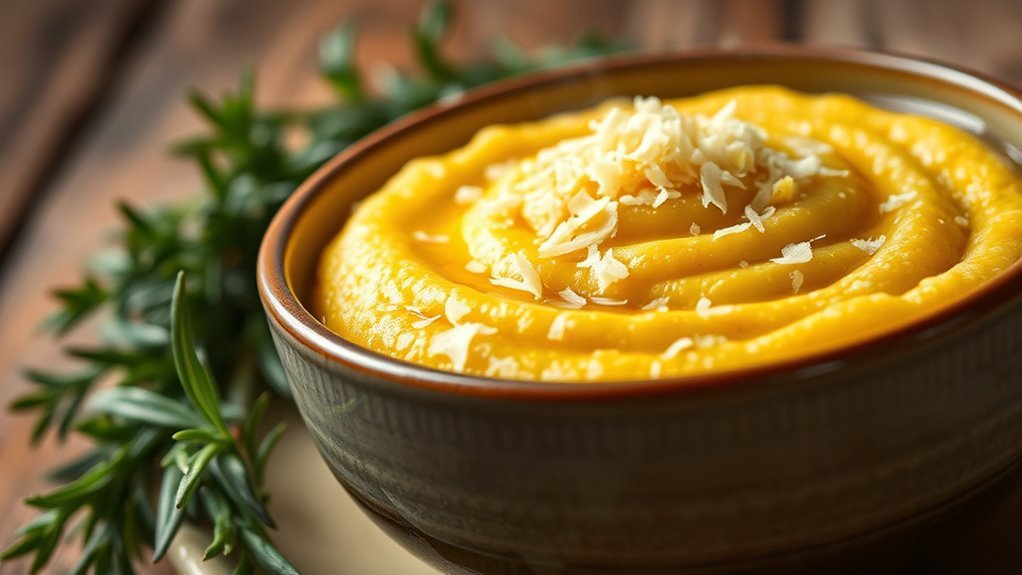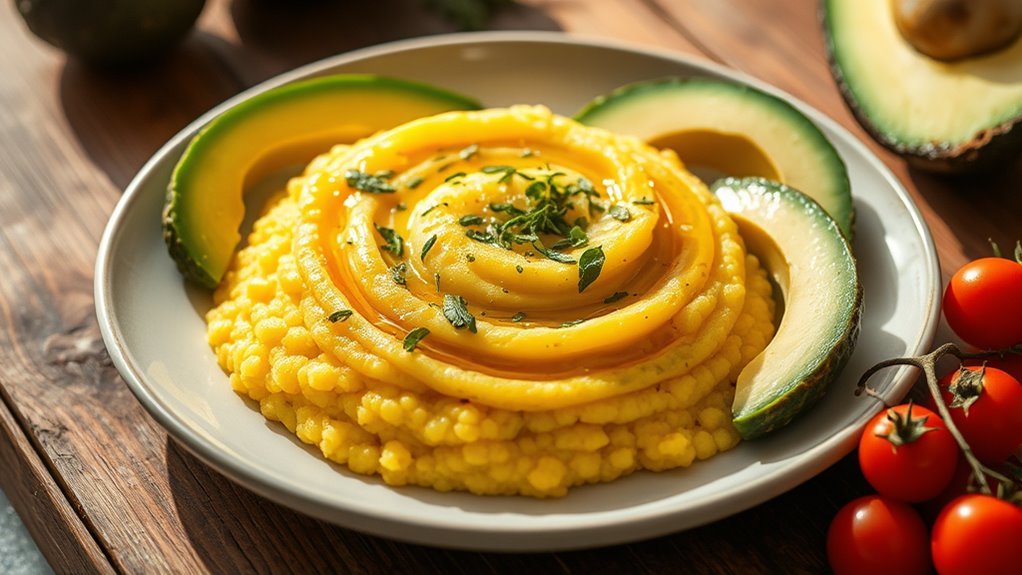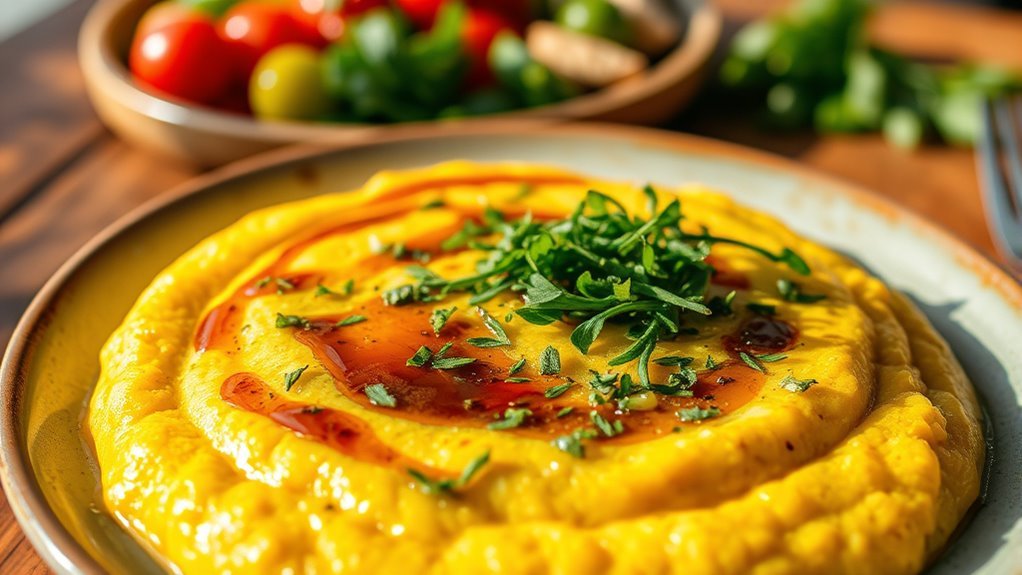Polenta isn’t typically keto-friendly due to its high carb content, which can range around 21 grams per 100 grams. This amount can easily exceed your daily carb limits for maintaining ketosis. While it offers some essential nutrients and can be gluten-free, it’s better to enjoy polenta in moderation and pair it with low-carb ingredients. If you’re keen on incorporating polenta into your keto lifestyle, you might find alternative options and recipes that fit your needs as you explore further.
Understanding Polenta and Its Ingredients

Polenta, a traditional Italian dish made from ground cornmeal, serves as a versatile base for various meals. Its origins trace back to ancient times when it was a staple for peasants, evolving over centuries into a beloved comfort food. You’ll find polenta varieties ranging from creamy to firm, depending on how it’s prepared. Soft polenta is often served as a side dish, while firmer versions can be sliced and grilled or baked. The beauty of polenta lies in its adaptability—it can be flavored with herbs, cheese, or vegetables to suit your taste. Whether you enjoy it as a warm porridge or a crispy cake, polenta offers a unique culinary experience rooted in tradition yet open to innovation.
Nutritional Breakdown of Polenta

When exploring polenta, it’s important to reflect on its nutritional profile, especially for those following specific dietary plans like keto. Different polenta varieties can offer varying nutritional benefits, but here’s a quick breakdown of what you might find per typical serving size (1 cup cooked):
- Calories: About 70-80 calories, depending on the preparation.
- Carbohydrates: Generally, 15-20 grams, which can be significant for keto followers.
- Fiber: Approximately 1-2 grams, which aids digestion but is still relatively low.
While polenta can be a versatile and comforting dish, if you’re keeping an eye on your carb intake, it’s crucial to take into account these factors. Always check specific serving sizes and nutritional labels to make informed choices!
Carbohydrate Content in Polenta

When considering polenta’s place in a keto diet, you’ll want to look closely at its carbohydrate content. Typically, one cup of cooked polenta contains around 30 grams of carbs, which can be a significant portion of your daily limit on a ketogenic eating plan. Understanding this carb count is essential for making informed choices about including polenta in your meals.
Polenta’s Carb Count
How many carbohydrates does polenta actually contain? A serving of cooked polenta (about 1 cup) typically has around 30 grams of carbohydrates. If you’re curious about how that stacks up, consider these points:
- Fiber Content: Polenta does offer some dietary fiber, which can help moderate blood sugar levels.
- Polenta Recipes: Many popular polenta recipes utilize this grain, but they can quickly add carbs if you’re not careful.
- Polenta Alternatives: If you’re looking to reduce carbs, explore alternatives like cauliflower rice or zucchini noodles.
Understanding polenta’s carb count is essential for anyone monitoring their carbohydrate intake. This knowledge can empower you to make informed choices, allowing you the freedom to enjoy meals that align with your dietary goals.
Keto Diet Compatibility
Given polenta’s carbohydrate content, it’s important to assess its compatibility with a keto diet, which typically limits daily carb intake to around 20-50 grams. Polenta contains about 21 grams of carbs per 100 grams, making it quite high for keto standards. If you’re following keto diet basics, you might find that even a small serving could take up a significant portion of your carb allowance. For those looking for polenta alternatives, consider options like cauliflower rice or zucchini noodles, which are much lower in carbs. These substitutes can help you maintain your keto lifestyle while still enjoying satisfying meals. Ultimately, if you’re committed to keto, it’s best to steer clear of polenta to stay within your carb limits.
Comparing Polenta to Other Low-Carb Alternatives
When comparing polenta to other low-carb alternatives, it’s important to look at their nutritional profiles, flavor, and texture differences. You’ll find that options like cauliflower rice or zucchini noodles can provide a similar culinary experience while keeping carb counts lower. Additionally, exploring various cooking methods can enhance versatility in your meals, helping you stay on track with your keto goals.
Nutritional Profile Comparison
While polenta offers a comforting texture and flavor, its nutritional profile may not align with the goals of those following a keto diet. With approximately 21 grams of carbs per 100 grams, it’s essential to evaluate alternative options. Here’s a comparison with some polenta substitutes that work better for keto modifications:
- Cauliflower Rice: Only about 5 grams of carbs per 100 grams, making it a versatile and low-carb alternative.
- Zucchini Noodles: With around 3 grams of carbs per 100 grams, they’re light and offer a great texture.
- Shirataki Noodles: Virtually zero carbs, these noodles are an excellent option for those needing to minimize carb intake.
Exploring these options can provide you with the freedom to enjoy satisfying meals while staying true to your keto goals.
Flavor and Texture Differences
Polenta’s creamy texture and slightly sweet flavor can make it a comforting staple in many dishes, but when considering low-carb alternatives, the flavors and textures can vary greatly. For instance, cauliflower rice offers a subtle crunch with a mild flavor profile, making it versatile but less satisfying for those craving polenta’s creaminess. Zucchini noodles, on the other hand, provide a fresh, watery texture that may not satisfy your desire for something hearty. In contrast, shirataki noodles have a unique, chewy texture but can be an acquired taste. Each alternative presents its own texture variations and flavor profiles, so experimenting with them can help you find the perfect fit for your low-carb lifestyle while still enjoying diverse dishes.
Cooking Methods and Versatility
Although polenta is a beloved comfort food, its cooking methods and versatility can be compared to various low-carb alternatives that cater to different dietary needs. Here’s how polenta stacks up against some popular options:
- Cauliflower Rice: This low-carb favorite can be sautéed or steamed, offering a flexible base for a variety of versatile dishes.
- Zoodles (Zucchini Noodles): You can spiralize zucchini and quickly sauté or serve them raw, providing a revitalizing and low-carb alternative to pasta.
- Shirataki Noodles: Made from konjac root, these noodles require minimal cooking and absorb flavors well, making them a unique and versatile option.
While polenta has its merits, experimenting with these alternatives can enhance your low-carb cooking techniques and expand your meal options.
How Polenta Affects Ketosis
How does polenta impact your state of ketosis? Polenta, derived from corn, is high in carbohydrates, which can hinder your ability to maintain ketosis. Depending on the polenta types—instant, quick-cooking, or traditional—carb counts can vary, but it generally contains too many carbs for a strict keto diet. For instance, one cup of cooked polenta can have around 30 grams of carbs, which is often more than your daily limit on a keto plan. If you’re seeking keto alternatives, consider cauliflower rice or zucchini noodles, which offer lower-carb options while still providing a satisfying texture. Ultimately, if you’re committed to staying in ketosis, it’s best to limit or avoid polenta altogether.
Ways to Incorporate Polenta in a Keto Diet
If you’re looking to incorporate polenta into a keto diet, it’s important to be mindful of portion sizes and the overall carbohydrate content. Here are some creative ways to enjoy polenta while keeping your macros in check:
- Polenta Substitutions: Use cauliflower or zucchini as a base for dishes that typically call for polenta, providing a similar texture with lower carbs.
- Keto Meal Prep: Prepare small servings of polenta to pair with high-fat toppings like cheese, avocado, or olive oil, ensuring you maintain your carb limits.
- Polenta Bowls: Create a keto-friendly bowl by layering polenta with grilled vegetables and a protein of your choice, keeping the portions balanced for your diet.
This mindful approach allows you to enjoy polenta while staying true to your keto goals.
Potential Health Benefits of Polenta
While you might think of polenta as just a comfort food, it actually offers several potential health benefits that can be quite beneficial in moderation. Polenta is made from cornmeal, which provides essential nutrients like iron, magnesium, and B vitamins. These nutrients can support energy production and overall well-being. Additionally, polenta is gluten-free, making it a great option for those with gluten sensitivities.
However, it’s important to take into account portion sizes, as polenta is primarily a carbohydrate source. When incorporating it into your diet, balance it with healthy fats and proteins to maintain stable blood sugar levels. Overall, understanding these polenta benefits and health considerations can help you enjoy this dish while supporting your nutritional goals.
Common Keto-Friendly Recipes With Polenta
Although polenta is typically considered a high-carb food, there are creative ways to incorporate it into a keto-friendly diet. You can explore various polenta dishes by using low-carb alternatives or modifying traditional recipes. Here are three ideas to get you started:
- Polenta Pizza Base: Use a firm polenta base topped with low-carb veggies and cheese for a delicious pizza alternative.
- Creamy Polenta with Cauliflower: Blend cooked polenta with riced cauliflower to reduce carbs while maintaining a creamy texture.
- Polenta Fries: Bake polenta strips until crispy, then serve with keto-friendly dipping sauces.
Making Mindful Choices: When to Enjoy Polenta
When considering how to incorporate polenta into your diet, it’s important to be mindful of your overall carb intake and nutritional goals. Polenta can be a delicious addition, but you’ll want to indulge in mindful moderation. When preparing polenta, consider pairing it with low-carb vegetables or healthy fats to balance the meal. Enjoy polenta as a treat on special occasions or when you’ve factored it into your daily carb allowance. Remember, the preparation method can also impact its nutritional profile; opting for baked or grilled versions can be healthier than frying. By making informed choices, you can savor polenta without straying from your keto journey. So, enjoy your freedom to choose while keeping your goals in sight!
Frequently Asked Questions
Can I Eat Polenta on Strict Keto Diets?
If you’re on a strict keto diet, you might want to rethink polenta. It’s made from corn, which is higher in carbs compared to other low carb options. Instead, consider keto alternatives like cauliflower rice or zucchini noodles, which can fit your dietary needs better. While polenta can be delicious, sticking to lower-carb choices helps you stay in ketosis and enjoy the freedom of your diet without compromising your goals.
Is There a Gluten-Free Version of Polenta?
Yes, there’s a gluten-free version of polenta since it’s made from cornmeal, which naturally doesn’t contain gluten. If you’re looking for polenta alternatives, consider using other gluten-free grains like quinoa, rice, or buckwheat to diversify your meals. These options can add variety while still catering to your dietary preferences. Just be certain to check labels and recipes to confirm they meet your specific needs, allowing you the freedom to enjoy delicious, gluten-free dishes!
How Does Polenta Fit Into Meal Prepping?
Polenta’s like a blank canvas, ready for your culinary artistry. When meal prepping, its versatility shines. Cooked polenta can be stored in the fridge for up to a week, making it a convenient option. You can slice, reheat, or even sauté it for quick meals. If you’re looking for polenta alternatives, consider cauliflower mash or zucchini noodles for a lower-carb twist. Embrace these options and let your creativity flow!
What Are the Best Toppings for Keto Polenta?
When you’re looking to top your keto polenta, consider savory toppings that enhance flavor while keeping carbs low. Some great cheese options include creamy goat cheese, sharp cheddar, or Parmesan, which add richness without excess carbs. You can also add sautéed mushrooms, spinach, or crispy bacon for extra texture and taste. Experiment with herbs and spices to elevate your dish, allowing you to enjoy a delicious, satisfying meal while staying true to your keto goals.
Can I Freeze Leftover Polenta?
Can you really keep polenta fresh for later? Absolutely! For polenta storage, freezing is a great option. Just let it cool completely, then cut it into portions. Wrap each piece in plastic wrap, followed by aluminum foil, to prevent freezer burn. When you’re ready to enjoy it again, thaw it in the fridge overnight and reheat gently. With the right freezing techniques, you can savor that delicious polenta without wasting any!


